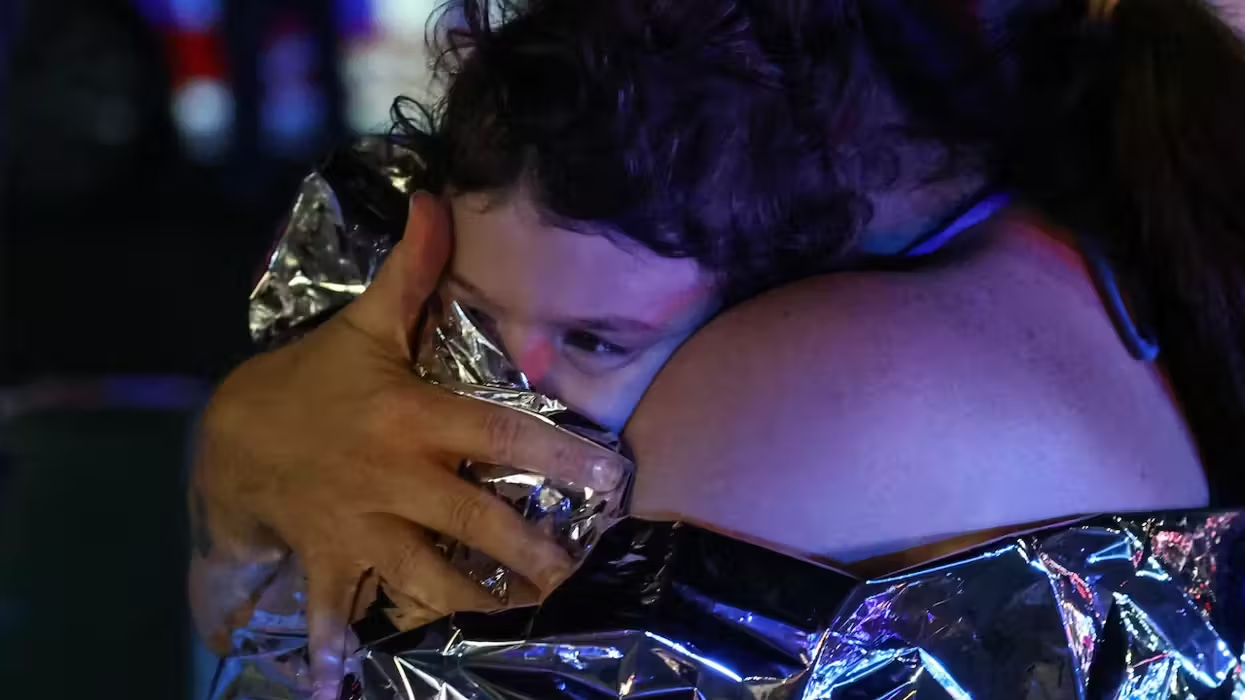
© 2025 Blaze Media LLC. All rights reserved.
Scary': Parents Explain the Hardship for Children With Spina Bifida -- Even After Fetal Surgery
July 12, 2012
“Sometimes, she’ll take off one brace and put on what she calls a ‘pretty shoe.'"
Editor’s Note: This is the fourth in a five part series where The Blaze has looked into a newer treatment for children diagnosed with spina bifida. While most would have the hole exposing his or her spine closed after birth, more than a decade ago surgeries that were considered controversial at the time began where the hole was closed in utero in the hopes of reversing some of the disabling effects of the disorder.
The first results of a federally funded human trial were released in 2011, showing the success seen in the new treatment thus far. We’ve talked to families who had the elective surgery before it ever entered a formal human trial and those who more recently have had the surgery since the period trial ended. We’ve timed this series to specifically run close to Glenn Beck’s Restoring Love as the parents of children who underwent the surgery, many of whom still have some disability, want the world to know the blessing of celebrating differences.
Ask any parent of a child with spina bifida who has had a fetal surgery to correct the hole in their child’s spine before they were born and they’ll be sure to tell you this procedure is not a cure for all the effects that can come with the defect.
While in the third article in this series published on The Blaze Wednesday highlighted many of the positive outcomes fetal surgeries can have for children with the congenital defect, this is not to say children who have had the surgery as a treatment do not still have difficulties. Some have had a more difficult time than others.
As with any major surgery, a fetal operation is a risk for both the mother and the infant. Before the mother is cleared to receive the surgery, she is put through a rigorous round of meetings -- some lasting two days -- where hospital ethicists share every possible outcome that could happen to the baby. They tour the neonatal intensive care unit where their baby could very well end up after such a procedure. At this point, some mothers opt to have the traditional after-birth surgery. Others decide it’s worth the risk.
(Related: Exclusive: Medical Experts Explain How to Treat Spinal Defect Before a Child Is Even Born)
Although the National Institute of Health study -- results from which were presented in February 2011 -- revealed so many positive outcomes for reversing some of the negative effects of spina bifida, there is always the possibility the child could die as an infant after the surgery or even some years later. The are also other hardships that may still need to be overcome.
‘He never really woke up’

Christina Banks remembers it feeling like things were in slow motion when she found out her fetal baby boy had spina bifida. Like many families, the process from diagnosis to decision to have the fetal surgery went very quickly. There is a short timeframe to operate in the womb for it to be considered more effective compared to repairing the spine after birth. She explains how she and her husband and other children drove for two days from Arizona to Nashville to have the surgery at Vanderbilt University Medical Center. Within a week, the procedure was performed on the fetal Isaiah and six days later they were already driving back home. Christina would later deliver in Arizona.
Isaiah had a hard time from the very beginning. He was born at 30 weeks weighing 3 pounds 4 ounces. His first hospital stay -- out of the womb -- was a month and a half long.
“It was scary,” Banks said. “I was scared to hold him the first time because he was so tiny.”
A mere six months later, Isaiah was back in the hospital to receive his first shunt, a pump that would drain the fluid on his brain. He would have eight shunt revisions, each with a lengthy hospital stay. At 2 years old, he started suffering from a Chiari malformation -- a condition where the brain doesn’t sit properly above the spine and can cause pressure that would block the flow of cerebrospinal fluid resulting in hydrocephalus. Because of this condition, he had to have the back part of his skull and first few vertebrae removed so his brain had room to grow.
This surgery, though, left his neck unstable. Banks said he wore a neck brace with the expectation it would grow strong, but it never did. Up until this point Banks said he was pulling himself up, moving around, and was generally a happy kid. With his neck in this unstable condition, Banks said her son could have become a quadriplegic if it was not corrected.

On Feb. 8, 2006, a surgery took place that would fuse his neck to stabilize his head. After six hours the doctor came into the waiting room. He said something had gone horribly wrong. Christina explained that while the surgeons were placing a screw into Isaiah's skull, an artery was hit and he had a stroke on the table. A week later he had a brain aneurysm -- followed by three others.
After two and a half months, by the time the Banks family went home with their son, he never opened his eyes, talked or ate again.
“From that day on he never really woke up,” Banks said.
The family gained some hope when he eventually started to cry after a month. A month after that, he smiled. Still, he never recovered. Isaiah began to suffer seizures, got sicker and was admitted back into the hospital.

“On Nov. 19, 2010, we signed a DNR [do not resuscitate],” Banks said. He was eventually released only to return a week later -- on his birthday.
On July 19, 2011, Isaiah had passed away. Banks said every month since, on the 19th she has a bad day.
“I don’t think it gets better,” Banks said. “I am friends with a Facebook group for moms who have lost their kids. I’ve asked does it get better and everyone says “no.”
Banks says she would still have a fetal surgery again, if she had to go back. “I’ve seen so much good that it has done for others.”
The surgery that ‘saves kid's lives’
Not all outcomes are as tragic as that experienced by the Banks family, but many cases still come with their own trials.
Nannette and Ched Salasek were taking their family out for a fun day in March 2012. They went to see a movie and then made a spur of the moment stop at Chuck-E-Cheese. Although this might sound like a typical child’s birthday treat, all these activities are because their 9-year-old Annie was having surgery the following Monday.
Click through this photo gallery of Annie as she grew up:
Annie has one of the worst prognosis of spina bifida you can get. She had a fetal surgery in the hopes of mitigating some of the effects on an exposed neural tube. Up until 7 months old, Annie was doing pretty well. Things first went poorly when Ched and Nannette were at a restaurant with Annie and she spiked a 105 fever. She had a kidney infection. From there, the couple learned that Annie, like many children with spina bifida would have problems with her bowel and bladder function.
Since then, other than frequent urinary tract infections, Annie was meeting other milestones like “normal” kids. But for many parents, and for Annie as she grew, taking care of one of her most vital bodily functions became even more important. That’s when Nannette learned about the Malone Antegrade Continence Enema (MACE) surgery.
“This surgery saves kid’ lives,” Nannette said.
Essentially, instead of having an embarrassing colostomy bag, which Nanette more simply explains as a bag for stool, or having to take a rectal enema, Annie now is able to take care of herself at her convenience. The MACE surgery creates a stoma at the belly button or other area where one can insert a catheter and hook themselves up to an IV bag full of water.
“You just sit on the potty and it flushes them out. Takes an hour or so each night, but it’s life changing,” Nanette said.
Granted, Nannette said MACE is still considered a major surgery. Recovery is not easy. The reason the Salasek family was having a fun day on that March Saturday is because Annie would be having another surgery to change the location where she could “cath” herself.
This surgery, like any, would cause physical suffering, but Nannette says Annie at least enjoys the one-on-one time she gets with mom when she’s in the hospital, not to mention the mac-and-cheese.
Sometimes it’s the little things
While learning to “cath” oneself as early as age five and being fearful of having accidents in class as they get older is a valid concern and complaint for these children -- as well as those with spina bifida who had surgery after birth -- sometimes it’s the little things that are heartbreaking.
For example, Nannette said Annie gets bummed she can’t wear flip flops due to the braces she needs to support herself while walking.
“Sometimes, she’ll take off one brace and put on what she calls a ‘pretty shoe’,” Nannette said.
In addition to hardships experienced by the child -- everything from impaired physical movement to sometimes having extra problems with math -- many parents have described the toll of having a child with a disability can take on a marriage. Some marriages haven't survived it. Others say it is difficult but they can't imagine getting through these tough situations without their spouses.
This story has been updated to include more photos.
Stay tuned for the fifth and final installation of this series tomorrow where the Blaze will cover what the future of fetal research is with regard to spina bifida and how new institutions are beginning to look into performing fetal surgeries themselves but many find it too rigorous of a process. We will also look at some of the reunions had in the "fetal surgery family."
Want to leave a tip?
We answer to you. Help keep our content free of advertisers and big tech censorship by leaving a tip today.
Want to join the conversation?
Already a subscriber?
more stories
Sign up for the Blaze newsletter
By signing up, you agree to our Privacy Policy and Terms of Use, and agree to receive content that may sometimes include advertisements. You may opt out at any time.
Related Content
© 2025 Blaze Media LLC. All rights reserved.
Get the stories that matter most delivered directly to your inbox.
By signing up, you agree to our Privacy Policy and Terms of Use, and agree to receive content that may sometimes include advertisements. You may opt out at any time.






